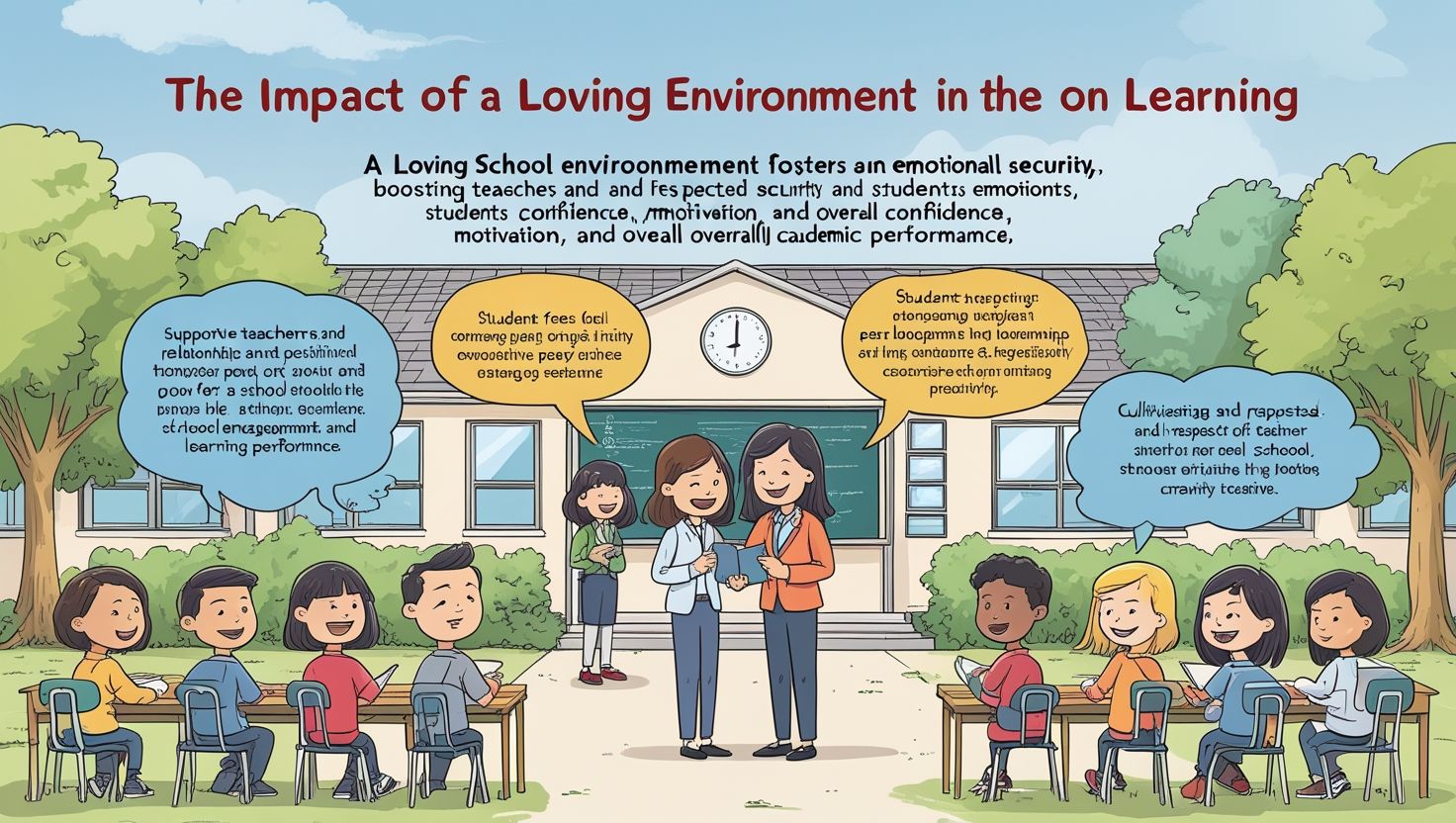The Impact of a Loving Environment in a School on Learning, Education is not merely the transmission of knowledge from teacher to student; it is a holistic process that shapes the intellectual, emotional, and social development of individuals. While curriculum, teaching methods, and resources are critical components of education, the environment in which learning takes place plays an equally significant role. A loving, supportive, and nurturing school environment can profoundly impact students’ ability to learn, grow, and thrive. This article explores the importance of a loving environment in schools, its effects on learning outcomes, and how educators and institutions can foster such an atmosphere.
Understanding a Loving Environment in Schools
A loving environment in a school is one where students feel valued, respected, and cared for. It is characterized by positive relationships between teachers and students, a sense of belonging, and an emphasis on emotional well-being. In such an environment, students are encouraged to express themselves, take risks, and learn from their mistakes without fear of judgment or ridicule. Key elements of a loving school environment include:
- Emotional Safety: Students feel secure and supported, knowing that their feelings and experiences are acknowledged.
- Positive Relationships: Teachers and peers build trust, empathy, and mutual respect.
- Inclusivity: Every student, regardless of their background, abilities, or challenges, feels included and valued.
- Encouragement and Motivation: Students are encouraged to pursue their interests and are motivated to achieve their potential.
- Holistic Development: The school prioritizes not only academic success but also emotional, social, and physical well-being.

The Impact of a Loving Environment on Learning
A loving environment in a school has far-reaching effects on students’ learning experiences and outcomes. Below are some of the key ways in which such an environment influences learning:
1. Enhanced Emotional Well-Being
Emotional well-being is the foundation of effective learning. When students feel loved and supported, they experience lower levels of stress, anxiety, and fear. This emotional stability allows them to focus better, engage more deeply with the material, and retain information more effectively. Research has shown that students who feel emotionally secure are more likely to participate in class, ask questions, and take intellectual risks.
2. Improved Academic Performance
A loving environment fosters a growth mindset, where students believe that their abilities can improve with effort and practice. Teachers who provide encouragement and constructive feedback help students build confidence in their abilities. This confidence translates into better academic performance, as students are more willing to tackle challenging tasks and persist in the face of difficulties.
3. Stronger Social Skills
Schools are not just places for academic learning; they are also social environments where students learn to interact with others. In a loving environment, students develop empathy, cooperation, and conflict-resolution skills. These social skills are essential for collaboration, teamwork, and building healthy relationships, both in school and later in life.
4. Increased Motivation and Engagement
When students feel cared for and valued, they are more likely to be motivated and engaged in their learning. A loving environment nurtures intrinsic motivation, where students learn because they are curious and passionate, not just because they want to earn grades or avoid punishment. This intrinsic motivation leads to deeper learning and a lifelong love of learning.
5. Reduced Behavioral Issues
A loving environment helps prevent behavioral issues by addressing the root causes of negative behavior, such as feelings of neglect, frustration, or low self-esteem. When students feel understood and supported, they are less likely to act out or disengage from school. Instead, they are more likely to exhibit positive behaviors, such as cooperation, respect, and responsibility.
6. Development of Resilience
Life is full of challenges, and resilience is a critical skill for navigating them. In a loving school environment, students learn to cope with setbacks and failures in a healthy way. Teachers who provide emotional support and encouragement help students develop resilience, enabling them to bounce back from difficulties and continue striving toward their goals.
7. Fostering Creativity and Innovation
A loving environment encourages students to think creatively and explore new ideas without fear of failure. When students feel safe to express themselves and take risks, they are more likely to think outside the box and come up with innovative solutions to problems. This creativity is essential for success in the 21st century, where innovation and adaptability are highly valued.

How to Create a Loving Environment in Schools
Creating a loving environment in a school requires intentional effort from educators, administrators, and the broader school community. Below are some strategies for fostering such an environment:
1. Build Positive Teacher-Student Relationships
Teachers play a central role in creating a loving environment. They can build positive relationships with students by showing genuine care, listening to their concerns, and providing encouragement. Simple gestures, such as greeting students by name, acknowledging their efforts, and offering support when needed, can go a long way in making students feel valued.
2. Promote a Culture of Respect and Inclusivity
Schools should actively promote a culture of respect and inclusivity, where every student feels welcome and accepted. This can be achieved by celebrating diversity, addressing bullying and discrimination, and ensuring that all students have equal opportunities to participate and succeed.
3. Prioritize Social-Emotional Learning (SEL)
Social-emotional learning (SEL) programs teach students essential skills such as self-awareness, empathy, and conflict resolution. By integrating SEL into the curriculum, schools can help students develop the emotional intelligence needed to navigate relationships and challenges effectively.
4. Create Safe Spaces for Expression
Schools should provide safe spaces where students can express their thoughts, feelings, and concerns without fear of judgment. This could include counseling services, peer support groups, or classroom discussions focused on emotional well-being.
5. Encourage Collaboration and Teamwork
Collaborative activities, such as group projects and team sports, help students build positive relationships with their peers. These activities also teach valuable skills such as communication, cooperation, and problem-solving.
6. Recognize and Celebrate Achievements
Celebrating students’ achievements, both big and small, helps build their self-esteem and motivation. Schools can recognize achievements through awards, certificates, or public acknowledgment in assemblies or newsletters.
7. Involve Parents and the Community
A loving school environment extends beyond the classroom. Schools can involve parents and the broader community in creating a supportive network for students. This could include parent-teacher associations, community service projects, or family-oriented events.
8. Provide Professional Development for Educators
Educators need training and support to create and maintain a loving environment. Professional development programs can equip teachers with the skills and knowledge needed to address students’ emotional and social needs effectively.
Challenges and Considerations
While the benefits of a loving environment in schools are clear, creating and maintaining such an environment is not without challenges. Some of the potential obstacles include:
- Resource Constraints: Schools with limited resources may struggle to implement SEL programs or provide counseling services.
- Resistance to Change: Some educators and administrators may be resistant to shifting away from traditional, academically focused approaches.
- Balancing Academics and Well-Being: Schools must strike a balance between academic rigor and emotional well-being, ensuring that one does not come at the expense of the other.
- Cultural Differences: What constitutes a loving environment may vary across cultures, requiring schools to be sensitive to the needs and values of their diverse student populations.
Despite these challenges, the long-term benefits of a loving environment far outweigh the difficulties. By prioritizing emotional well-being and positive relationships, schools can create a foundation for lifelong learning and success.
Conclusion
A loving environment in a school is not a luxury; it is a necessity for effective learning and holistic development. When students feel loved, supported, and valued, they are more likely to thrive academically, socially, and emotionally. Educators and institutions have a responsibility to create such an environment by building positive relationships, promoting inclusivity, and prioritizing emotional well-being. In doing so, they can empower students to reach their full potential and become compassionate, resilient, and lifelong learners. As the African proverb says, “It takes a village to raise a child,” and a loving school environment is a vital part of that village.

5 thoughts on “The Impact of a Loving Environment in a School on Learning”
Comments are closed.